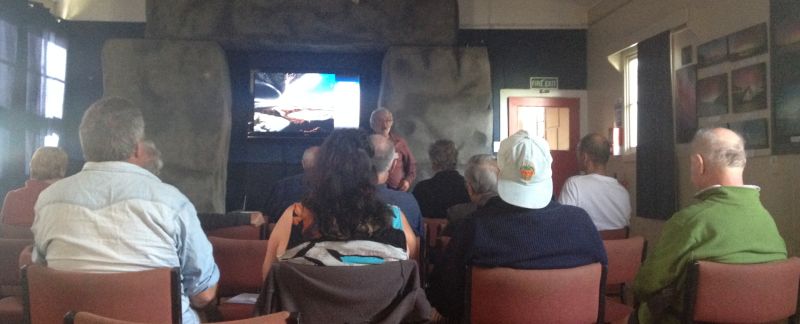
During the weekend of 13th to 15th of May, just under 40 people enjoyed a comprehensive tour of the solar system. While the skies had been stunning for weeks prior to the event, unfortunately wind and clouds prevented the use of telescopes over this time. Never-the-less the excellent presentations, personal learning, social connections and in-depth discussions created an enthusiastic buzz that participants will long remember.
Friday evening saw presentations covering all aspects of the solar system from the oldest Greek astronomers, to the latest discoveries and the many different types of worlds and objects it encompasses. A sturdy group of long-lasters stayed for a late night sci-fi fix when observing had to be cancelled.
Into the weekend proper, Saturday morning started early with the kid’s astronomy lead by George. The number of kids was easily matched or exceeded by the number of much older individuals. Saturday was very busy with talks on solar storms and their enormous impact on our planet and issues with global conservation. A voyage to the Ice Giants was then presented including the current hunt for the elusive ninth planet, far out in the distant reaches of the solar system.
Ian Cooper again amazed participants with his knowledge of the oppositions of Mars over the years and Richard followed this up with an in-depth examination of Mars from the past to the present. Delving into ancient cultures and records, Louise Thomas explained the development of many of our modern units of time and the division of the year into months, weeks and days. Why is the week 7 days rather than 6, why not a five-day week?
Saturday's presentations were rounded out by Kay's exposition, delving into the wonderful jewel that is Saturn. We were treated to the latest theories about the rings, a look at the moons and an examination of the planet itself. For most people the evening then ended with a laser tour of the night sky lead by Ian. The laser danced around the clouds and at times we could not help but be impressed when he told us that a certain star or constellation, was right up there just behind that cloud. Finally, a few intrepid stalwarts hunkered down to enjoy historical sci-fi with a viewing of "The Thing."
The next day rolled along and there we were, Sunday already. An exciting section of the programme still to go. Ian began proceedings with an in-depth look at comets. He looked at their origins, features, and some of the historical drawings and photos explaining how people reacted to these portents in the sky.
The final day continued with the exploration of the dwarf planets, focussing mainly on Ceres and Pluto. Edwin amazed the audience with photographs and explanations of the most recent visits to these tiny worlds. The final fate of our own star was expertly covered by Dr Dennis Sullivan in his explanations of White Dwarfs and some of the related bizarre objects out in the stellar garden of our galaxy.
Once again Richard moved to the presenter’s podium and delivered a treatise on Jupiter, explaining how it is more like the sun than just another planet. We looked at the "sub-solar-system" it commands and how these moons are each unique and fascinating. We viewed rings and electro-magnetic fields and how these phenomena create an environment dangerous for mankind, but possibly harbouring life.
Throughout this weekend the meal times and tea and coffee breaks provided opportunities to question and discuss the presentation topics and other astronomical practicalities. These social times are in many ways as important as the formal programme itself and were enjoyed by all who attended. Cameron Smart followed the afternoon tea with a historical look at the development of radar and radio astronomy by New Zealanders since its earliest times. We learned about war time secrets and how in some ways New Zealand led the world is areas of radar development.
Rounding out the weekend Kay took us on a tour of the newest discoveries for solar systems beyond our own. The presentation of exo-planets and how they were found in the late 20th century, through to the latest sophisticated technologies looking for these amazing worlds. Kay's talk finished the weekend on a high note that tickled the imagination and made one want to enjoy another weekend like this in the future.
Finally, I would like to express thanks to all the presenters and quiet background workers who made this amazing weekend so much of a buzz. Congratulations to all those who enjoyed the weekend and a note to any who missed, make sure you keep your eye on the calendar for future events. This really was a brilliant experience.
Paul Curry
Friday evening saw presentations covering all aspects of the solar system from the oldest Greek astronomers, to the latest discoveries and the many different types of worlds and objects it encompasses. A sturdy group of long-lasters stayed for a late night sci-fi fix when observing had to be cancelled.
Into the weekend proper, Saturday morning started early with the kid’s astronomy lead by George. The number of kids was easily matched or exceeded by the number of much older individuals. Saturday was very busy with talks on solar storms and their enormous impact on our planet and issues with global conservation. A voyage to the Ice Giants was then presented including the current hunt for the elusive ninth planet, far out in the distant reaches of the solar system.
Ian Cooper again amazed participants with his knowledge of the oppositions of Mars over the years and Richard followed this up with an in-depth examination of Mars from the past to the present. Delving into ancient cultures and records, Louise Thomas explained the development of many of our modern units of time and the division of the year into months, weeks and days. Why is the week 7 days rather than 6, why not a five-day week?
Saturday's presentations were rounded out by Kay's exposition, delving into the wonderful jewel that is Saturn. We were treated to the latest theories about the rings, a look at the moons and an examination of the planet itself. For most people the evening then ended with a laser tour of the night sky lead by Ian. The laser danced around the clouds and at times we could not help but be impressed when he told us that a certain star or constellation, was right up there just behind that cloud. Finally, a few intrepid stalwarts hunkered down to enjoy historical sci-fi with a viewing of "The Thing."
The next day rolled along and there we were, Sunday already. An exciting section of the programme still to go. Ian began proceedings with an in-depth look at comets. He looked at their origins, features, and some of the historical drawings and photos explaining how people reacted to these portents in the sky.
The final day continued with the exploration of the dwarf planets, focussing mainly on Ceres and Pluto. Edwin amazed the audience with photographs and explanations of the most recent visits to these tiny worlds. The final fate of our own star was expertly covered by Dr Dennis Sullivan in his explanations of White Dwarfs and some of the related bizarre objects out in the stellar garden of our galaxy.
Once again Richard moved to the presenter’s podium and delivered a treatise on Jupiter, explaining how it is more like the sun than just another planet. We looked at the "sub-solar-system" it commands and how these moons are each unique and fascinating. We viewed rings and electro-magnetic fields and how these phenomena create an environment dangerous for mankind, but possibly harbouring life.
Throughout this weekend the meal times and tea and coffee breaks provided opportunities to question and discuss the presentation topics and other astronomical practicalities. These social times are in many ways as important as the formal programme itself and were enjoyed by all who attended. Cameron Smart followed the afternoon tea with a historical look at the development of radar and radio astronomy by New Zealanders since its earliest times. We learned about war time secrets and how in some ways New Zealand led the world is areas of radar development.
Rounding out the weekend Kay took us on a tour of the newest discoveries for solar systems beyond our own. The presentation of exo-planets and how they were found in the late 20th century, through to the latest sophisticated technologies looking for these amazing worlds. Kay's talk finished the weekend on a high note that tickled the imagination and made one want to enjoy another weekend like this in the future.
Finally, I would like to express thanks to all the presenters and quiet background workers who made this amazing weekend so much of a buzz. Congratulations to all those who enjoyed the weekend and a note to any who missed, make sure you keep your eye on the calendar for future events. This really was a brilliant experience.
Paul Curry
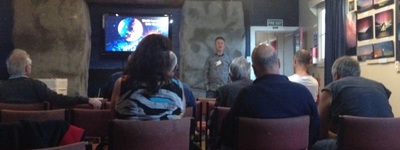
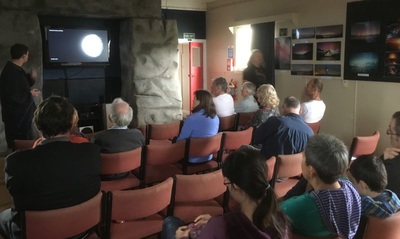
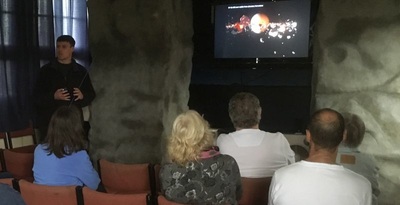
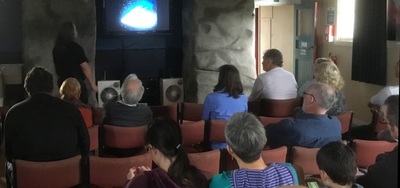
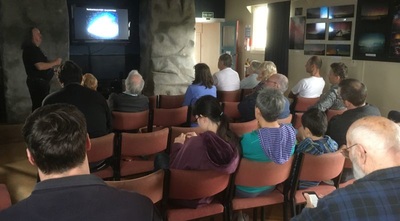
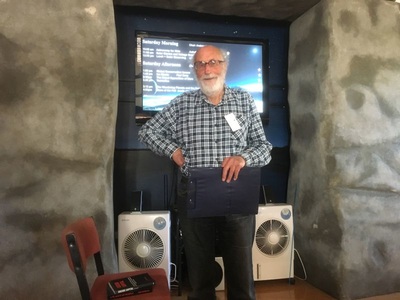
 RSS Feed
RSS Feed